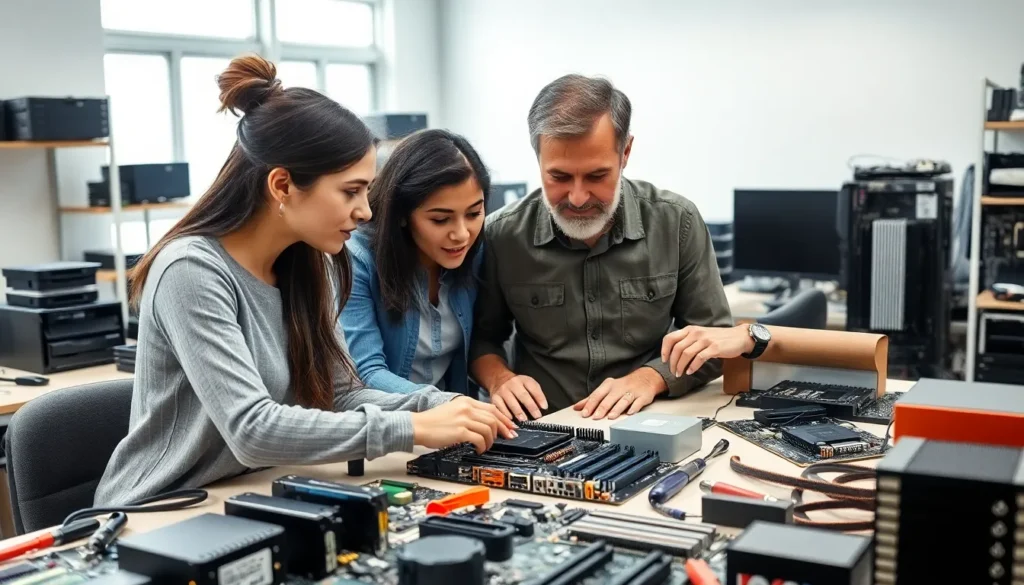Table of Contents
ToggleIn a world where technology evolves faster than a caffeinated squirrel, hardware remains the backbone of every device we rely on. From the trusty old computer that’s seen better days to the sleek, new gadgets that promise to make life easier, understanding hardware is essential for anyone who wants to keep up with the digital age.
Overview of Hardware
Hardware encompasses the physical components of computer systems and devices. Processors, memory, storage devices, and peripheral equipment form the core elements that execute computing tasks. Each category plays a distinct role in the overall performance of a machine.
Processors, also known as CPUs, handle instructions and process data. They come in various types, including multi-core and single-core, with performance levels that directly affect computing speed. Memory, particularly RAM, temporarily stores data that the CPU accesses during tasks, impacting multitasking capabilities.
Storage comes in two primary forms: HDD and SSD. HDDs offer larger capacities at lower costs but are slower than SSDs, which provide faster data access. Many devices utilize a combination of both for optimal performance and capacity.
Peripheral devices enhance user experience and functionality. Input devices, like keyboards and mice, facilitate user interaction with systems. Output devices such as monitors and printers convey information back to users. Communication devices, including network cards, allow connectivity between systems for data exchange.
Understanding hardware’s various components offers a solid foundation for navigating the digital landscape. Knowledge of hardware specifications, compatibility, and performance characteristics aids in making informed decisions when purchasing or upgrading devices. As technology continues to advance, staying informed about hardware trends ensures better adaptability in an increasingly digital world.
Types of Hardware

Understanding the various types of hardware is vital to grasping their roles within computer systems. Each category supports different functions and enhances user experience.
Input Devices
Input devices serve as the bridge between users and computers. Key examples include keyboards and mice, which facilitate data entry and command execution. Other notable input devices are scanners, which convert physical documents into digital formats, and microphones that capture audio. Touchscreens provide direct interaction, allowing users to navigate interfaces with their fingers. These devices play critical roles in ensuring efficient communication between users and machines.
Output Devices
Output devices display or convey the results of computer processes to users. Monitors function as primary output devices, presenting visual information, while printers produce hard copies of documents and images. Speakers deliver audio output, enhancing multimedia experiences. Projectors enable presentation of visual content on larger screens for group settings. Each output device caters to different needs, ensuring users receive information in accessible forms.
Storage Devices
Storage devices are essential for holding data long-term. Hard Disk Drives (HDDs) offer significant capacity for affordable storage, while Solid State Drives (SSDs) provide faster data access speeds. External drives and USB flash drives enable additional storage flexibility. Cloud storage services allow users to store and access data remotely, offering benefits like collaboration and data backup. Understanding the variety of storage solutions helps users select options that best fit their needs.
Importance of Hardware in Computing
Hardware serves as the backbone of all computing devices. Understanding its components is essential for navigating today’s technology. Processors determine the speed of data processing, influencing overall computing performance. Memory plays a critical role in multitasking efficiency, with RAM impacting how many applications run simultaneously.
Storage devices also affect how information is retained. Different types of storage, like HDDs and SSDs, vary in both speed and capacity, catering to distinct user needs. Peripheral devices, including keyboards and mice, facilitate interaction, enhancing user experience and productivity.
Input devices bridge the gap between users and computers. They help users efficiently enter data and execute commands. Output devices, such as monitors and printers, present processed information in usable formats. These components work together to create a seamless computing experience.
In discussions about hardware, familiarity with specifications becomes crucial. Knowledge of performance characteristics helps users make informed choices when purchasing or upgrading devices. Staying updated on hardware trends allows for better adaptation to evolving technology, ensuring users remain competitive in the digital landscape.
Awareness of hardware’s importance also extends to software compatibility. Certain software requires specific hardware capabilities for optimal performance. Recognizing the relationship between software and hardware enables users to avoid potential issues.
Hardware’s significance in computing cannot be understated. Every component contributes to a device’s overall functionality. Understanding these elements empowers users to optimize their computing experiences effectively.
Latest Trends in Hardware Technology
Hardware technology continuously evolves, significantly impacting computing capabilities and user experiences.
Innovations in Processing Power
Processors have undergone substantial improvements, with a clear focus on enhancing performance. They now feature advanced architectures, enabling faster data processing and energy efficiency. Integration of AI capabilities into chips allows for quick decision-making and seamless processing tasks. Multi-core processors dominate the market, facilitating better multitasking and smoother operations. Emerging technologies like quantum computing show promise in revolutionizing speed and problem-solving capabilities. With each advancement, users can expect devices that handle complex tasks more efficiently.
Advances in Storage Solutions
Storage technology is adapting rapidly to meet increasing data demands. Solid-state drives (SSDs) are becoming standard due to their speed and durability. Offering faster load times, these drives enhance overall performance for gaming and productivity. Innovations like NVMe technology further boost data transfer rates, linking storage and processing mechanisms closely. Additionally, cloud storage solutions offer scalable options for data retention, allowing users to access files from anywhere. As a result, organizations benefit from improved data management and enhanced operational efficiency.
Hardware Maintenance and Upgrades
Routine maintenance extends the lifespan of hardware and enhances performance. Cleaning dust from internal components prevents overheating, ensuring optimal functioning. Regularly updating drivers also helps maintain hardware efficiency by maximizing compatibility with the latest software.
Upgrading components can significantly boost performance. Increasing RAM enables better multitasking, allowing users to run multiple applications simultaneously. Replacing traditional HDDs with SSDs enhances speed, reducing boot times and load times for applications.
Selecting compatible upgrades plays a crucial role in successful modifications. Assessing device specifications before purchasing components ensures that new parts work seamlessly with existing hardware. Checking user reviews and compatibility lists aids in making informed choices.
Periodically evaluating hardware requirements aligns upgrades with current usage needs. Understanding software demands helps pinpoint which upgrades provide the most benefit. For instance, gamers might prioritize a powerful graphics card, while professionals may focus on larger storage capacity.
Investing in preventive care also ensures longevity. Using surge protectors minimizes damage from power fluctuations. Furthermore, running diagnostic tools can identify potential issues before they escalate into expensive repairs.
Diligent maintenance preserves hardware health. Thoughtful upgrades improve overall functionality, meeting evolving demands. Staying informed about compatibility and user needs can enhance a computing experience sustainably.
Understanding hardware is vital for navigating today’s tech-driven world. As technology continues to advance at a rapid pace, staying informed about hardware components and trends ensures users can optimize their devices effectively.
Routine maintenance and thoughtful upgrades not only enhance performance but also extend the lifespan of hardware. By recognizing the significance of each component and its role in overall functionality, individuals can make informed decisions that align with their computing needs.
Embracing the latest advancements in hardware technology prepares users for future developments and helps them remain competitive in an ever-evolving digital landscape.




